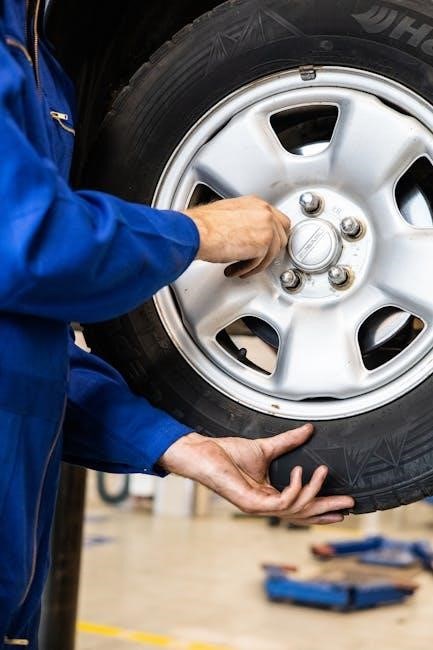The Tire Minder Manual serves as a comprehensive guide for understanding and utilizing tire pressure monitoring systems (TPMS) to enhance driving safety and tire longevity․ It provides detailed instructions for installation, setup, and maintenance, ensuring users can monitor tire pressure and temperature in real-time․ This manual is essential for optimizing vehicle performance and preventing potential hazards associated with improper tire inflation․ By following the guidelines, drivers can ensure their tires remain in optimal condition, reducing the risk of accidents and extending tire life․ The manual also emphasizes the importance of regular checks and troubleshooting to maintain system accuracy and reliability․ Whether you’re a seasoned driver or a new user, this manual offers clear, step-by-step guidance to help you make the most of your TPMS․ Its user-friendly approach ensures that you can confidently manage your tire health, contributing to a safer and more efficient driving experience․
What is a Tire Minder Manual?
A Tire Minder Manual is a detailed guide designed to help users understand and effectively use a Tire Pressure Monitoring System (TPMS)․ It provides comprehensive instructions for installing, setting up, and maintaining the system to ensure optimal tire performance and safety․ The manual typically includes step-by-step guides for sensor installation, system calibration, and troubleshooting common issues․ It also explains how to interpret real-time data, such as tire pressure and temperature readings, and how to respond to alerts for high or low pressure conditions․ By following the manual, users can ensure their TPMS functions accurately, helping to prevent tire damage, improve fuel efficiency, and enhance overall driving safety․ The manual is an essential resource for anyone looking to maximize the benefits of their TPMS and maintain their vehicle’s tires in the best possible condition․
The Importance of Tire Pressure Monitoring Systems (TPMS)

Tire Pressure Monitoring Systems (TPMS) play a crucial role in ensuring vehicle safety, efficiency, and performance․ By continuously monitoring tire pressure and temperature, TPMS helps prevent accidents caused by under-inflated tires, which can lead to reduced traction, uneven tire wear, and increased risk of blowouts․ Proper tire inflation improves fuel efficiency, enhances vehicle handling, and extends tire lifespan․ TPMS also provides real-time alerts for high or low pressure conditions, allowing drivers to address issues promptly․ This proactive monitoring system is essential for maintaining optimal tire health and ensuring safe driving conditions․ Modern vehicles rely on TPMS to meet safety standards, making it an indispensable feature for drivers․ By adhering to the guidelines in the Tire Minder Manual, users can fully utilize their TPMS to enhance their driving experience and protect their investment in their vehicle․
Evolution of TPMS Technology
The evolution of Tire Pressure Monitoring Systems (TPMS) has transformed from basic pressure checks to advanced real-time monitoring solutions․ Early systems relied on indirect monitoring, using wheel speed sensors to detect pressure changes, but modern TPMS now utilize direct sensors inside tires for precise data․ These sensors measure pressure and temperature, transmitting information to a central display․ Advances in wireless communication, such as Bluetooth and radio frequency, have enhanced reliability and reduced installation complexity․ Additionally, integration with vehicle computers allows for seamless alerts and system resets․ The development of user-friendly manuals, like the Tire Minder Manual, has made TPMS more accessible, guiding users through installation, setup, and troubleshooting․ Today, TPMS is a standard safety feature, with ongoing innovations focusing on low-power designs and expanded monitoring capabilities for trailers and caravans, ensuring safer and more efficient driving experiences․

Installation and Setup of the Tire Minder System
Mount sensors on each tire valve and sync with the display․ Power on the display first, attach sensors, ensuring alignment․ Follow manual for sensor matching and calibration․
Step-by-Step Installation Guide
Begin by powering on the Tire Minder display before installing sensors to ensure proper synchronization․
Mount sensors on each tire valve, following the manufacturer’s alignment instructions․
Turn on the system and allow it to automatically detect and pair sensors with the display․
Enter the tire matching state by pressing the Menu Key 8 times continuously․
Select the appropriate tire for each sensor, ensuring correct pairing․
Set the high-pressure alarm by navigating to the system settings and inputting your desired pressure limit․
Test the system by driving the vehicle to ensure real-time monitoring of tire pressure and temperature․
Refer to the manual for troubleshooting if sensors fail to sync or display incorrect data․
By following these steps, you can successfully install and set up your Tire Minder system for reliable tire monitoring․
Sensor Matching Process
The sensor matching process ensures each tire sensor is correctly paired with the Tire Minder system․ Start by powering on the display and entering the system settings․ Press the Menu Key 8 times to access the tire match state․ The left front wheel icon will flash, indicating the system is ready to pair․ Select the tire you wish to match using the navigation buttons․ Repeat this process for each tire, ensuring the correct sensor is assigned to each wheel․ Once all sensors are paired, the system will display real-time data for each tire․ If pairing fails, restart the process or refer to the manual for troubleshooting․ Proper sensor matching is crucial for accurate tire pressure and temperature monitoring, ensuring your safety on the road․
Setting Up the High-Pressure Alarm
To set up the high-pressure alarm, navigate to the system settings by holding the Menu Key for 3 seconds․ Press the Menu Key 3 times to access the high-pressure alarm setting․ Use the navigation buttons to set the desired upper pressure limit for your tires․ Once set, the system will alert you if the pressure exceeds this threshold․ This feature ensures you’re notified of over-inflation, which can lead to reduced traction and increased risk of tire damage․ After setting, save the configuration to ensure the alarm is active․ Proper setup of the high-pressure alarm is crucial for maintaining tire health and safety․ Always refer to your vehicle’s recommended tire pressure levels when configuring this setting․ If issues arise, consult the manual for troubleshooting steps to ensure accurate functionality․ This feature enhances your driving safety by providing real-time alerts for potential tire over-inflation․

Features and Functionality of the Tire Minder System
The Tire Minder System offers real-time monitoring of tire pressure and temperature, providing high and low-pressure alerts․ It supports both manual and digital gauges for accurate readings and enhanced safety․
Real-Time Tire Pressure and Temperature Monitoring
One of the standout features of the Tire Minder System is its ability to provide real-time monitoring of tire pressure and temperature․ This ensures that drivers are always informed about the condition of their tires, whether they are stationary or on the move․ The system automatically detects and displays pressure levels as soon as the vehicle starts, offering precise readings that help maintain optimal tire performance․ Temperature monitoring adds an extra layer of safety, as excessive heat can indicate potential issues like improper inflation or mechanical stress․ By keeping a constant watch on these critical metrics, the Tire Minder System enhances driving safety, improves fuel efficiency, and prolongs tire lifespan․ This feature is particularly beneficial for long trips or towing, where tire health is paramount․ The real-time data ensures prompt alerts for any deviations, allowing drivers to address problems before they escalate․ This seamless monitoring system is a cornerstone of the Tire Minder Manual’s functionality․
High and Low Tire Pressure Alerts

The Tire Minder System includes advanced alerts for high and low tire pressure, ensuring drivers are immediately notified of any deviations from the recommended levels․ These alerts are triggered when tire pressure falls below or rises above the set thresholds, providing a clear warning to take action․ The system offers customizable high-pressure alarms, allowing users to define the upper limit for pressure, which is particularly useful for varying load conditions․ Low-pressure alerts are equally critical, as underinflated tires can lead to reduced traction, increased wear, and potential blowouts․ Audible and visual notifications ensure drivers are alerted promptly, even when they are not actively monitoring the system․ This feature enhances safety by enabling drivers to address issues before they become critical, thereby improving overall vehicle performance and reducing the risk of accidents․ Regular monitoring of these alerts helps maintain optimal tire condition and ensures a smoother driving experience․
Manual vs․ Digital Tire Pressure Gauges
When monitoring tire pressure, drivers can choose between manual and digital tire pressure gauges, each offering distinct advantages․ Manual gauges rely on a dial or needle to indicate pressure, providing a straightforward, analog measurement․ They are simple to use and require no power source, making them a reliable option for quick checks․ Digital gauges, on the other hand, offer precise, real-time readings displayed on an LCD screen, often with additional features like temperature monitoring and programmable alerts․ While manual gauges are cost-effective and easy to maintain, digital gauges provide greater accuracy and convenience, especially for frequent monitoring․ The choice between the two depends on personal preference, driving habits, and the level of technology desired․ Both options ensure accurate tire pressure readings, which are essential for safety and optimal vehicle performance․ Regular use of either gauge helps maintain proper tire inflation and reduces the risk of tire-related issues․

Maintenance and Troubleshooting

Regularly clean tire sensors, check for system updates, and ensure all components are securely connected․ Refer to the manual for specific troubleshooting steps to maintain optimal performance․
Regular Maintenance Tips for TPMS
Regular maintenance of your Tire Pressure Monitoring System (TPMS) is crucial to ensure its accuracy and reliability․ Start by cleaning the sensors periodically to remove dirt or dust that may interfere with performance․ Check for software updates and install them as needed to keep the system up-to-date․ Inspect the sensors and valves for damage or wear, replacing them if necessary․ After tire rotations or replacements, ensure the sensors are properly tightened to avoid leaks․ Additionally, monitor the battery levels of the sensors and replace them when low․ Finally, always refer to the manual for specific maintenance recommendations tailored to your system․ By following these steps, you can prevent potential issues and ensure your TPMS operates effectively, providing consistent and accurate tire pressure readings․

Resolving Low Tire Pressure Warnings
Low tire pressure warnings are common issues that can arise with your TPMS․ If a warning light appears, start by checking the tire pressure using a reliable manual or digital gauge․ Compare the readings with the recommended levels specified in your vehicle’s manual․ If the pressure is low, inflate the tires to the suggested levels and recheck․ Ensure the tires are cold for an accurate reading․ After inflating, the TPMS may automatically reset, but if the warning persists, you may need to manually reset the system․ This is often done through a relearn process outlined in your manual․ If the issue recurs or the system malfunctions, inspect the sensors for damage or corrosion and replace them if necessary․ Regular checks and timely adjustments will help prevent false alarms and ensure your TPMS functions correctly, maintaining safety and efficiency on the road․

How to Reset the Tire Pressure Monitoring System
To reset the Tire Pressure Monitoring System (TPMS), start by ensuring all tires are inflated to the recommended pressure, as specified in your vehicle’s manual․ Turn on the ignition but do not start the engine․ Press and hold the TPMS reset button, usually located under the steering wheel or in the glove compartment, for 3-5 seconds until the warning light blinks․ Release the button and turn off the ignition․ If your vehicle does not have a reset button, press the Menu Key 5 times to enter the system setting mode and follow the on-screen instructions․ Some systems require a relearn process after sensor replacement or battery replacement․ Always refer to your manual for specific instructions, as procedures may vary by vehicle make and model․ After resetting, drive the vehicle at a speed of at least 20 mph for a few minutes to allow the system to recalibrate․ If the warning light persists, check for sensor issues or consult a professional․

The Tire Minder Manual provides a comprehensive guide to enhancing driving safety and performance through proper TPMS usage․ Additional resources are available for further detailed information․
Final Thoughts on the Tire Minder Manual
The Tire Minder Manual is an essential resource for anyone seeking to optimize their vehicle’s tire pressure monitoring system (TPMS) for enhanced safety and performance․ By following the guidelines outlined in this manual, users can ensure their tires are always at the correct pressure, reducing the risk of accidents and improving fuel efficiency․ The manual’s step-by-step instructions and troubleshooting tips make it user-friendly, even for those unfamiliar with TPMS technology․ Real-time monitoring, high-pressure alerts, and maintenance tips are just a few features highlighted to promote safe driving practices․ Whether you’re a seasoned driver or a new vehicle owner, this manual provides the tools needed to maintain optimal tire health․ Its practical advice and clear explanations make it a valuable companion for any driver looking to enhance their driving experience and protect their investment․
Importance of Safety and Proper Usage
Proper usage of the Tire Minder Manual ensures optimal safety and performance of your tire pressure monitoring system (TPMS)․ Maintaining correct tire pressure is crucial for vehicle stability, fuel efficiency, and preventing accidents․ Underinflated tires can lead to reduced traction, increased stopping distances, and higher risk of tire failure, especially at high speeds․ Regularly monitoring tire pressure and addressing low-pressure alerts helps prevent these hazards․ Additionally, following the manual’s guidelines ensures the TPMS functions accurately, providing reliable real-time data․ Neglecting these steps can compromise safety and lead to premature tire wear․ By adhering to the manual’s instructions, drivers can enjoy enhanced safety, improved vehicle handling, and extended tire life․ Proper usage not only protects the driver but also passengers and other road users, making it a critical aspect of responsible vehicle ownership․
Recommended Reading and Resources
For a deeper understanding of the Tire Minder Manual and tire pressure monitoring systems (TPMS), several resources are available to enhance your knowledge; The official Tire Minder Manual is the primary source for detailed instructions and troubleshooting guides․ Additionally, manufacturer websites often provide supplementary materials, such as installation videos and FAQs․ Technical papers on TPMS technology offer insights into system functionality and advancements․ Online forums and communities dedicated to automotive maintenance can also provide practical tips and user experiences․ For visual learners, instructional YouTube videos demonstrate TPMS installation and setup․ Lastly, industry publications on tire safety emphasize the importance of proper tire maintenance․ Exploring these resources ensures a comprehensive understanding of TPMS, enabling users to maximize system benefits and maintain optimal tire health․ These materials are invaluable for both new and experienced users seeking to improve their vehicle’s safety and performance․

No Responses